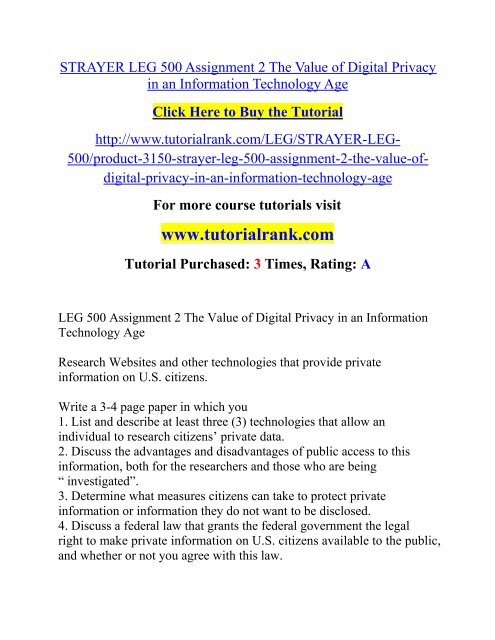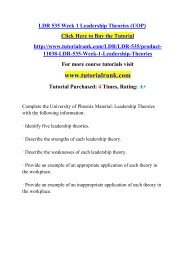STRAYER LEG 500 Assignment 2 The Value of Digital Privacy in an Information Technology Age(Uop)/TutorialRank
LEG 500 Assignment 2 The Value of Digital Privacy in an Information Technology Age Research Websites and other technologies that provide private information on U.S. citizens. Write a 3-4 page paper in which you 1. List and describe at least three (3) technologies that allow an individual to research citizens’ private data. 2. Discuss the advantages and disadvantages of public access to this information, both for the researchers and those who are being “ investigated”. 3. Determine what measures citizens can take to protect private information or information they do not want to be disclosed. 4. Discuss a federal law that grants the federal government the legal right to make private information on U.S. citizens available to the public, and whether or not you agree with this law.
LEG 500 Assignment 2 The Value of Digital Privacy in an Information Technology Age
Research Websites and other technologies that provide private information on U.S. citizens.
Write a 3-4 page paper in which you
1. List and describe at least three (3) technologies that allow an individual to research citizens’ private data.
2. Discuss the advantages and disadvantages of public access to this information, both for the researchers and those who are being “ investigated”.
3. Determine what measures citizens can take to protect private information or information they do not want to be disclosed.
4. Discuss a federal law that grants the federal government the legal right to make private information on U.S. citizens available to the public, and whether or not you agree with this law.
You also want an ePaper? Increase the reach of your titles
YUMPU automatically turns print PDFs into web optimized ePapers that Google loves.
<strong>STRAYER</strong> <strong>LEG</strong> <strong>500</strong> <strong>Assignment</strong> 2 <strong>The</strong> <strong>Value</strong> <strong>of</strong> <strong>Digital</strong> <strong>Privacy</strong><br />
<strong>in</strong> <strong>an</strong> <strong>Information</strong> <strong>Technology</strong> <strong>Age</strong><br />
Click Here to Buy the Tutorial<br />
http://www.tutorialr<strong>an</strong>k.com/<strong>LEG</strong>/<strong>STRAYER</strong>-<strong>LEG</strong>-<br />
<strong>500</strong>/product-3150-strayer-leg-<strong>500</strong>-assignment-2-the-value-<strong>of</strong>digital-privacy-<strong>in</strong>-<strong>an</strong>-<strong>in</strong>formation-technology-age<br />
For more course tutorials visit<br />
www.tutorialr<strong>an</strong>k.com<br />
Tutorial Purchased: 3 Times, Rat<strong>in</strong>g: A<br />
<strong>LEG</strong> <strong>500</strong> <strong>Assignment</strong> 2 <strong>The</strong> <strong>Value</strong> <strong>of</strong> <strong>Digital</strong> <strong>Privacy</strong> <strong>in</strong> <strong>an</strong> <strong>Information</strong><br />
<strong>Technology</strong> <strong>Age</strong><br />
Research Websites <strong>an</strong>d other technologies that provide private<br />
<strong>in</strong>formation on U.S. citizens.<br />
Write a 3-4 page paper <strong>in</strong> which you<br />
1. List <strong>an</strong>d describe at least three (3) technologies that allow <strong>an</strong><br />
<strong>in</strong>dividual to research citizens’ private data.<br />
2. Discuss the adv<strong>an</strong>tages <strong>an</strong>d disadv<strong>an</strong>tages <strong>of</strong> public access to this<br />
<strong>in</strong>formation, both for the researchers <strong>an</strong>d those who are be<strong>in</strong>g<br />
“ <strong>in</strong>vestigated”.<br />
3. Determ<strong>in</strong>e what measures citizens c<strong>an</strong> take to protect private<br />
<strong>in</strong>formation or <strong>in</strong>formation they do not w<strong>an</strong>t to be disclosed.<br />
4. Discuss a federal law that gr<strong>an</strong>ts the federal government the legal<br />
right to make private <strong>in</strong>formation on U.S. citizens available to the public,<br />
<strong>an</strong>d whether or not you agree with this law.
5. Determ<strong>in</strong>e whether there are “electronic privacy laws” that c<strong>an</strong><br />
prevent others from hav<strong>in</strong>g access to “private <strong>in</strong>formation” as well as<br />
how effective they are.<br />
<strong>The</strong> specific course learn<strong>in</strong>g outcomes associated with this <strong>LEG</strong> <strong>500</strong><br />
<strong>Assignment</strong> are<br />
• Analyze employee <strong>an</strong>d consumer privacy under the law.<br />
• Use technology <strong>an</strong>d <strong>in</strong>formation resources to research issues <strong>in</strong> law,<br />
ethics, <strong>an</strong>d corporate govern<strong>an</strong>ce.<br />
• Write clearly <strong>an</strong>d concisely about law, ethics, <strong>an</strong>d corporate<br />
govern<strong>an</strong>ce us<strong>in</strong>g proper writ<strong>in</strong>g mech<strong>an</strong>ics.<br />
Grad<strong>in</strong>g for this <strong>LEG</strong> <strong>500</strong> <strong>Assignment</strong> will be based on <strong>an</strong>swer quality,<br />
logic / org<strong>an</strong>ization <strong>of</strong> the paper, <strong>an</strong>d l<strong>an</strong>guage <strong>an</strong>d writ<strong>in</strong>g skills, us<strong>in</strong>g<br />
the follow<strong>in</strong>g rubric.<br />
Po<strong>in</strong>ts 100 <strong>LEG</strong> <strong>500</strong> <strong>Assignment</strong> 2 <strong>The</strong> <strong>Value</strong> <strong>of</strong> <strong>Digital</strong> <strong>Privacy</strong> <strong>in</strong> <strong>an</strong><br />
<strong>Information</strong> <strong>Technology</strong> <strong>Age</strong><br />
Criteria Unacceptable<br />
Below 70% F Fair<br />
70-79% C Pr<strong>of</strong>icient<br />
80-89% B Exemplary<br />
90-100% A<br />
1. List <strong>an</strong>d describe at least three (3) technologies that allow <strong>an</strong><br />
<strong>in</strong>dividual to research citizens’ private data.<br />
Weight 15% Did not submit or <strong>in</strong>completely listed <strong>an</strong>d described at least<br />
three (3) technologies that allow <strong>an</strong> <strong>in</strong>dividual to research citizens’<br />
private data. Partially listed <strong>an</strong>d described at least three (3) technologies<br />
that allow <strong>an</strong> <strong>in</strong>dividual to research citizens’ private data. Satisfactorily<br />
listed <strong>an</strong>d described at least three (3) technologies that allow <strong>an</strong><br />
<strong>in</strong>dividual to research citizens’ private data. Thoroughly listed <strong>an</strong>d<br />
described at least three (3) technologies that allow <strong>an</strong> <strong>in</strong>dividual to<br />
research citizens’ private data.<br />
2. Discuss the adv<strong>an</strong>tages <strong>an</strong>d disadv<strong>an</strong>tages <strong>of</strong> public access to this<br />
<strong>in</strong>formation, both for the researchers <strong>an</strong>d those who are be<strong>in</strong>g<br />
“ <strong>in</strong>vestigated”.
Weight 20% Did not submit or <strong>in</strong>completely discussed the adv<strong>an</strong>tages<br />
<strong>an</strong>d disadv<strong>an</strong>tages <strong>of</strong> public access to this <strong>in</strong>formation, both for the<br />
researchers <strong>an</strong>d those who are be<strong>in</strong>g “<strong>in</strong>vestigated”. Partially discussed<br />
the adv<strong>an</strong>tages <strong>an</strong>d disadv<strong>an</strong>tages <strong>of</strong> public access to this <strong>in</strong>formation,<br />
both for the researchers <strong>an</strong>d those who are be<strong>in</strong>g “ <strong>in</strong>vestigated”.<br />
Satisfactorily discussed the adv<strong>an</strong>tages <strong>an</strong>d disadv<strong>an</strong>tages <strong>of</strong> public<br />
access to this <strong>in</strong>formation, both for the researchers <strong>an</strong>d those who are<br />
be<strong>in</strong>g “ <strong>in</strong>vestigated”. Thoroughly discussed the adv<strong>an</strong>tages <strong>an</strong>d<br />
disadv<strong>an</strong>tages <strong>of</strong> public access to this <strong>in</strong>formation, both for the<br />
researchers <strong>an</strong>d those who are be<strong>in</strong>g “ <strong>in</strong>vestigated”.<br />
3. Determ<strong>in</strong>e what measures citizens c<strong>an</strong> take to protect private<br />
<strong>in</strong>formation or <strong>in</strong>formation they do not w<strong>an</strong>t to be disclosed.<br />
Weight 15% Did not submit or <strong>in</strong>completely determ<strong>in</strong>ed what measures<br />
citizens c<strong>an</strong> take to protect private <strong>in</strong>formation or <strong>in</strong>formation they do<br />
not w<strong>an</strong>t to be disclosed. Partially determ<strong>in</strong>ed what measures citizens<br />
c<strong>an</strong> take to protect private <strong>in</strong>formation or <strong>in</strong>formation they do not w<strong>an</strong>t<br />
to be disclosed. Satisfactorily determ<strong>in</strong>ed what measures citizens c<strong>an</strong><br />
take to protect private <strong>in</strong>formation or <strong>in</strong>formation they do not w<strong>an</strong>t to be<br />
disclosed. Thoroughly determ<strong>in</strong>ed what measures citizens c<strong>an</strong> take to<br />
protect private <strong>in</strong>formation or <strong>in</strong>formation they do not w<strong>an</strong>t to be<br />
disclosed.<br />
4. Discuss a federal law that gr<strong>an</strong>ts the federal government the legal<br />
right to make private <strong>in</strong>formation on U.S. citizens available to the public<br />
<strong>an</strong>d whether or not you agree with this law.<br />
Weight 15% Did not submit or <strong>in</strong>completely discussed a federal law that<br />
gr<strong>an</strong>ts the federal government the legal right to make private <strong>in</strong>formation<br />
on U.S. citizens available to the public <strong>an</strong>d whether or not you agree<br />
with this law. Partially discussed a federal law that gr<strong>an</strong>ts the federal<br />
government the legal right to make private <strong>in</strong>formation on U.S. citizens<br />
available to the public <strong>an</strong>d whether or not you agree with this law.<br />
Satisfactorily discussed a federal law that gr<strong>an</strong>ts the federal government<br />
the legal right to make private <strong>in</strong>formation on U.S. citizens available to<br />
the public <strong>an</strong>d whether or not you agree with this law. Thoroughly<br />
discussed a federal law that gr<strong>an</strong>ts the federal government the legal right
to make private <strong>in</strong>formation on U.S. citizens available to the public <strong>an</strong>d<br />
whether or not you agree with this law.<br />
5. Determ<strong>in</strong>e whether there are “electronic privacy laws” that c<strong>an</strong><br />
prevent others from hav<strong>in</strong>g access to “private <strong>in</strong>formation” as well as<br />
how effective they are.<br />
Weight 15% Did not submit or <strong>in</strong>completely determ<strong>in</strong>ed whether there<br />
are “electronic privacy laws” that c<strong>an</strong> prevent others from hav<strong>in</strong>g access<br />
to “ private <strong>in</strong>formation” as well as how effective they are. Partially<br />
determ<strong>in</strong>ed whether there are “electronic privacy laws” that c<strong>an</strong> prevent<br />
others from hav<strong>in</strong>g access to “private <strong>in</strong>formation” as well as how<br />
effective they are. Satisfactorily determ<strong>in</strong>ed whether there are<br />
“electronic privacy laws” that c<strong>an</strong> prevent others from hav<strong>in</strong>g access to<br />
“private <strong>in</strong>formation” as well as how effective they are. Thoroughly<br />
determ<strong>in</strong>ed whether there are “electronic privacy laws” that c<strong>an</strong> prevent<br />
others from hav<strong>in</strong>g access to “private <strong>in</strong>formation” as well as how<br />
effective they are.<br />
6. Clarity, writ<strong>in</strong>g mech<strong>an</strong>ics, <strong>an</strong>d formatt<strong>in</strong>g requirements<br />
Weight 10%
















